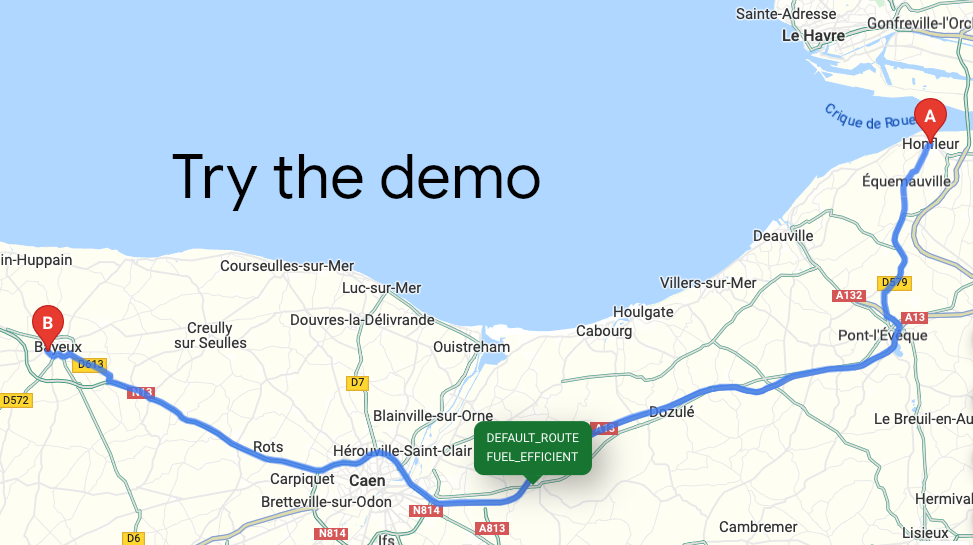简介
Compute Routes 是 Routes API 服务中的一种方法,可接受 HTTPS 请求并返回两个位置之间的理想路线。提供多个地点之间的公交、骑行、驾车、两轮机动车或步行路线及实时路况。
需要路线矩阵?如果您对路线矩阵感兴趣,请参阅计算路线矩阵概览。
正在迁移?如果您要从 Distance Matrix API(旧版)进行迁移,请参阅从为何要迁移到 Routes API 开始的迁移说明。
为何要使用 Compute Routes
借助 Compute Routes,您可以根据自己的偏好设置各种路线详细信息,从而规划车辆或包裹的路线,同时优化成本和质量。
您可以使用 Compute Routes 做些什么?
借助 Routes API 的 Compute Routes 方法,您可以执行以下操作:
查询不同出行方式的路线,以及前往单个或多个目的地的路线:
交通方式:公交、驾车、两轮车辆、步行或骑自行车。
一系列航点,您可以优化这些航点,以确定前往这些航点的最有效顺序。
使用多种方式指定起点、终点和途经点:
文本字符串。例如:“Chicago, IL”“Darwin, NT, Australia”“1800 Amphitheatre Parkway, Mountain View, CA 94043”或“CWF6+FWX Mountain View, California”
地点 ID
纬度和经度坐标,可选择性地包含车辆航向
根据您的需求和目标微调路线选项:
根据车辆的发动机类型(柴油、电动、混合动力、汽油)选择省油或节能路线。如需了解详情,请参阅获取环保路线。
设置精细的流量计算选项,让您在质量与延迟之间做出权衡。如需了解详情,请参阅指定是否以及如何纳入流量数据。
为途经点设置车辆航向(行驶方向)和道路一侧信息,以提高预计到达时间 (ETA) 的准确性。如需了解详情,请参阅指定车辆行驶方向和道路一侧。
请求获取路程距离和预计到达时间 (ETA),以及过路费信息。如需了解详情,请参阅计算路线的通行费。
使用字段掩码仅请求所需的数据,从而控制延迟时间和质量,这有助于避免不必要的处理时间和更高的请求结算费率。如需了解详情,请参阅选择要返回的信息。
Compute Routes 的运作方式
Routes API ComputeRoutes 方法接受包含请求详细信息的 JSON 请求正文的 HTTP POST 请求。必需的参数包括出发地、目的地、travelMode 以及用于指定要返回的字段的字段掩码。
示例
curl -X POST -d '{ "origin": { "address": "1800 Amphitheatre Parkway, Mountain View, CA 94043" }, "destination": { "address": "Sloat Blvd &, Upper Great Hwy, San Francisco, CA 94132" }, "travelMode": "DRIVE" }' \ -H 'Content-Type: application/json' -H 'X-Goog-Api-Key: YOUR_API_KEY' \ -H 'X-Goog-FieldMask: routes.duration,routes.distanceMeters' \ 'https://routes.googleapis.com/directions/v2:computeRoutes'
然后,该服务会计算所请求的路线,并返回您请求的字段。
资源
下表汇总了可通过 Routes API 的 Compute Routes 方法获得的资源,以及该方法返回的数据。
| 数据资源 | 返回的数据 | 返回格式 |
|---|---|---|
| ComputeRoutes | 返回路线的路线、路段和步数,以及备选路线(如果已请求)。 | JSON |
如何使用“计算路线”
| 1 | 开始设置 | 首先设置 Google Cloud 项目,然后按照后续的设置说明完成操作。 |
| 2 | 了解 Routes API 的结算方式 | 如需了解相关信息,请参阅用量和结算。 |
| 3 | 计算路线并查看响应 | 如需了解详情,请参阅获取路线和查看路线响应。 |
可用的客户端库
如需查看适用于 Compute Routes 的可用客户端库的列表,请参阅客户端库。


